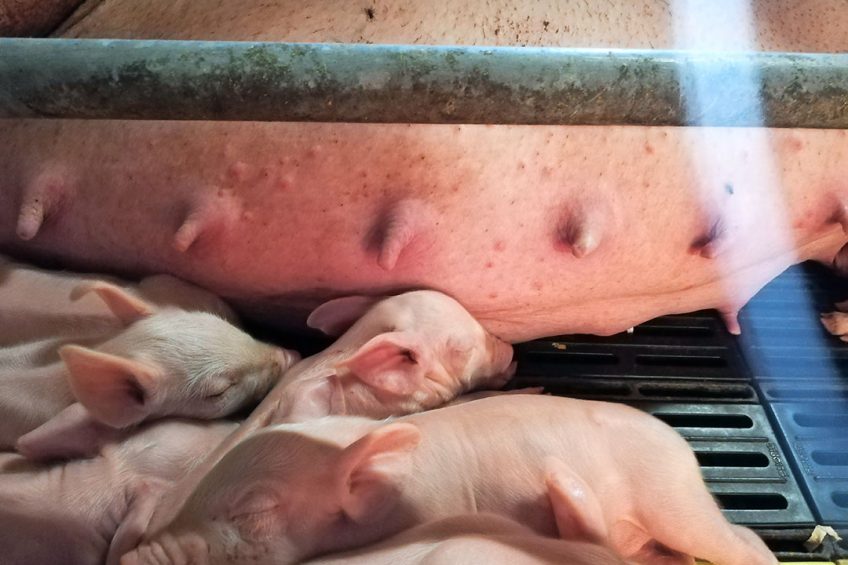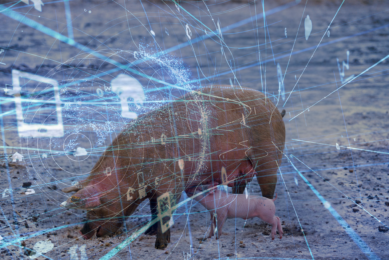Colostrum: Do sows achieve full potential?

Sows are exceptionally well equipped for their task: to provide colostrum and milk to their offspring. However, genetic progress in terms of sow prolificacy is changing the requirements of that valuable talent.
At farrowing, sows produce colostrum for about 24 hours. This helps piglets on their way, as they are born without any antibodies to protect them. Colostrum is an extremely rich source of antibodies (immunoglobulins), essential for the piglet’s defence against infections.
Warmth and energy
At birth, the piglet leaves the uterus at a temperature of approximately 38.5°C and enters into a farrowing room where the temperature is often in the range of 20–24°C (even though the creep area may be 30°C). The newborn piglet will quickly suffer from cold chills and will go into a negative energy balance. Apart from antibodies, the colostrum provides warmth and energy.
Back-fostering
After about 6 hours, changes start in the piglet’s gut mechanism. It becomes impervious to the passage of immunoglobulins and, after 24 hours, the piglet can no longer absorb them. It is common to see farrowing room caretakers ‘back-fostering’ small 3-day-old piglets onto newly farrowed sows ‘to give them more colostrum’. That provides no benefit at all.
Multiparous sows produce more colostrum
Colostrum production is higher in multiparous sows when compared to gilts. Studies from Padova University, Italy, on nearly 14,000 piglets showed a significant difference in the hazard ratio of survivability of third-parity sows compared to first-parity sows.
Higher prolificacy and increased variation
The Rutherford Report shows that over a 13-year period there has been an increase of 3.0 pigs born alive, which has provoked an increase of 5.4% in pre-weaning mortality. A French study from ITP on 12,000 piglets showed that as the average numbers born rose from below 11 to more than 16, the average birth weight declined from 1.59 kilogrammes to 1.26kg. More importantly, the percentage of piglets weighing less than 1.0kg increased from 7% to 23%.
Intrauterine growth retardation
The phenomenon intrauterine growth retardation (IUGR) is more frequent with hyperprolific sows. An interesting paper from 2019 clearly demonstrated the higher variability in birth weights in large litters. The low prolific group (10.25 born alive) had an average birth weight of 1.5kg with a standard deviation of 40 grammes, while the highly prolific group (14.69 born alive) had an average birth weight of 1.37kg but an enormous standard deviation of 220g.
A recent article in Pig Progress also mentioned that questions have been raised in both the Danish and Dutch parliaments about the welfare of piglets in highly prolific sows.
Unfortunately, at least 30% of hyperprolific sows do not produce enough colostrum
The limiting factor to sow productivity
It is generally recognised that the bare minimum piglet requirement is to receive 200g of colostrum over the first 24 hours. An intake of 250g has been shown to provide a very good chance of survival. Various research has shown high variability in colostrum yield, from a minimum of 900g up to 5,900g. A similar variation exists in the concentrations of immunoglobulin (IgG). Unfortunately, at least 30% of hyperprolific sows do not produce enough colostrum. They also have longer farrowings, which reduces colostrum yield. A litter of 16 will need 4,000g of colostrum over the first 24 hours. The quantity of colostrum intake affects not only pre-weaning mortality, but also mortality up to 42 days of age.
Hierarchy and the mammary gland
Any farrowing room caretaker will say that the strongest pigs will also take the front teats, the weakest the back teats. The growth rates follow a similar pattern. During a 21-day lactation, mammary tissue weight can increase by 50%. Similarly, mammary DNA can increase by 100%. Mammary growth is affected by litter size, dietary intake and gland location. To maximise mammary growth, all functional teats must be ‘milked’.
The gilt’s first lactation will determine her milking capacity in her future parities. The gilt should be allowed to suckle the same number of piglets as she has functional teats. In case of any pre-weaning mortality, other piglets should be fostered onto her to maintain the development of her mammary glands.
Heritability values
Various ieces of research have shown some very interesting heritability (h²) values related to teat development. Teat length has an h² of 0.46, and teat length is moderately correlated with daily gain. The same study of nearly 1,000 sows showed an h² for IgG production of 0.35. If a breeding company could start measuring IgG at nucleus level and add it into the breeding index, that would be a major step forward in reducing pre-weaning mortality. Work at Helsinki University, Finland, has shown a very good correlation between a handheld digital refractometer and detailed laboratory ELISA tests for IgG concentrations.
Type of farrowing crate
In recent years, there has been a move towards a ‘freedom’ type of farrowing pen. It is bigger than a normal farrowing pen, with a farrowing crate, that can be opened up after 24–72 hours. The suckling behaviour in these pens has been shown to be different from that in traditional farrowing pens. Milk let-down in crates lasted 8.5 seconds as opposed to 10.3 seconds in the pens. Due to better access to the teats, there were fewer teat fights in the pens and fewer piglets missed the milk let-downs. More importantly, the piglets that suckled in the pens had a higher weight gain.
When the sows are transferred into farrowing, an assessment should be made of their teat dimensions
Method of cross-fostering
The traditional way of cross-fostering was to try to even up the numbers, with maybe a few less on the gilts. When the individual teats are closely observed, the enormous variation in dimension becomes evident. A small 900g piglet will have little chance of obtaining colostrum from a teat that is 5.0 centimetres long. Similarly, a strong 1.8kg piglet will struggle to cope with very small teats.
When the sows are transferred into farrowing, an assessment should be made of their teat dimensions, large, medium and small. This should ideally be colour-marked onto their farrowing cards. The art of cross-fostering is much more successful when carried out by teat dimensions, rather than just by numbers.
How to increase colostrum production
Apart from genetic selection as previously mentioned, nutrition can play an important part in increasing the quantity and quality of colostrum produced. The inclusion of encapsulated medium and short-chain fatty acids in the gestation ration was studied at Queens University, Belfast, Northern Ireland, UK.
At farm level, the treated sows had reduced pre-weaning mortality, and their piglets had increased weaning weights. The detailed analysis of the colostrum showed significantly higher levels of the immunoglobulins IgG and IgM. The treated sows also had greater concentrations of fat and lactose. The concentrations of IgG in the piglets’ serum was studied at two and four weeks of age, and the piglets from treated sows had significantly higher levels of IgG.
Medium and short-chain fatty acids do not pass through sow milk. To understand the mechanism, the team in Belfast carried out a proteomic evaluation, which is the measure of expression genes through proteins. Basically, there are changes in the milk fat globule membranes. When they are down-regulated, more fat (which contains the immunoglobulins) stays in the milk.
References available on request.











